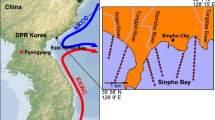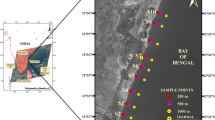Abstract
An artificial neural network (ANN) based chlorophyll-a algorithm was developed to estimate chlorophyll-a concentration using OCEANSAT-I Ocean Colour Monitor (OCM) satellite-data. A multi-layer perceptron (MLP) type neural network was trained using simulated reflectances (~60,000 spectra) with known chlorophyll-a concentration, corresponding to the first five spectral bands of OCM. The correlation coefficient(r 2) andRMSE for the log transformed training data was found to be 0.99 and 0.07, respectively. The performance of the developed ANN-based algorithm was tested with the global SeaWiFS Bio-optical Algorithm Mini Workshop (SeaBAM) data (~919 spectra), 0.86 and 0.13 were observed asr 2 andRMSE for the test data set. The algorithm was further validated with thein-situ bio-optical data collected in the northeastern Arabian Sea (~215 spectra), ther 2 andRMSE were observed as 0.87 and 0.12 for this regional data set. Chlorophyll-a images were generated by applying the weight and bias matrices obtained during the training, on the normalized water leaving radiances (nL W) obtained from the OCM data after atmospheric correction. The chlorophyll-a image generated using ANN based algorithm and global Ocean Chlorophyll-4 (OC4) algorithm was compared. Chlorophyll-a estimated using both the algorithms showed a good correlation for the open ocean regions. However, in the coastal waters the ANN algorithm estimated relatively smaller concentrations, when compared to OC4 estimated chlorophyll-a.
Similar content being viewed by others
References
Chauhan, P., Mohan, M., Sarangi, R. K., Kumari, B. and Nayak, S. (2002). Surface chlorophyll-a estimation in the Bay of Bengal using IRS-P4 ocean colour monitor (OCM) satellite data.International journal of Remote Sensing,23: 1663–1676.
Chauhan, P., Nagamani, P. V. and Nayak, S. (2005). Artificial neural network (ANN) based algorithms for chlorophyll estimation in Arabian Sea.Indian Journal of Marine Sciences,34: 368–373.
Cipollini, P., Corsini, G., Diani, M. and Grasso, R. (2001). Retrieval of sea water optically active parameters from hyperspectral data by means of generalized radial basis function neural networks.IEEE Transactions on Geoscience and Remote Sensing,39: 1508–1524.
Gordon, H.R. (1997). Atmospheric correction of ocean colour imagery in the earth observing system era,Journal of Geophysical Research,102: 17081–17106.
Gordon, H.R. and Morel, A. (1983). Remote Assessment of ocean color for interpretation of satellite visible imagery: a review. In Lecture Notes on Coastal and Estuarine Studies, Vol.4, M. Bowmen (ed.), Spinger-Verlag, 1-114.
Gross, L., Thiria, S., Frouin, R. and Mitchell, B.G. (2000). Artificial neural networks for modeling the transfer function between marine reflectance and phytoplankton chlorophyll-a concentration.Journal of Geophysical Research,105: 3483–3495.
Hu, Y. H. and Hwang J. N. (2002). Handbook of Neural Network Signal Processing. Edited by Y.H. Hu and J. N. Hwang, CRC press, Florida.
IOCCG (2000). Remote Sensing of Ocean Colour in Coastal, and other optically complex waters, Satyendranath S. (ed.). Report s of the International Ocean-Colour Coordinating Group, No. 3, IOCCG, Dartmouth, Canada.
Keiner, L.E. and Brown, C.W. (1999). Estimating oceanic chlorophyll concentrations with neural networks.International Journal of Remote Sensing,120: 189–194.
Lavender, S.J. and Nagur, C.R.C. (2002). Mapping coastal waters with high-resolution imagery: atmospheric correction of multi-height airborne imagery.Applied Optics,4: 50–55.
Morel, A. (1991). Light and marine photosynthesis: A spectral model with geochemical and climatological implications.Progress in Oceanography,26: 263–306.
O’Reilly, J.E., Maritorena, S., Mitchell, B.G., Scigal, D.A., Carder, K.L., Graver, S.A., Kahru, M. and McClain, C.R. (1998). Ocean colour chlorophyll algorithms for SeaWiFS.Journal of Geophysical Research,98: 22827–22841.
Ruddick, K.G., Ovidio, F. and Rijkeboer, M. (2000). Atmospheric correction of SeaWiFS imagery for turbid coastal and inland waters.Applied Optics,39: 897–912.
Siegel, D.A., Wang M.H., Maritorena, S. and Robinson, W. (2000). Atmospheric correction of satellite ocean colour imagery: the black pixel assumption.Applied Optics,39:3582–3591.
Tanaka, A., Kishino, M., Doerffer, R., Schiller, H.,Oishi, T. and Kubota, T. (2004). Development of a neural network algorithm for retrieving concentrations of chlorophyll, suspended sediment matter and yellow substance from radiance data of the ocean colour and temperature scanner.Journal of Ocenaography,50: 519–530.
Author information
Authors and Affiliations
Corresponding author
About this article
Cite this article
Nagamani, P.V., Chauhan, P. & Dwivedi, R.M. Estimation of chlorophyll-A concentration using an artificial neural network (ANN)-based algorithm with oceansat-I OCM data. J Indian Soc Remote Sens 35, 201–207 (2007). https://doi.org/10.1007/BF03013488
Received:
Revised:
Issue Date:
DOI: https://doi.org/10.1007/BF03013488




